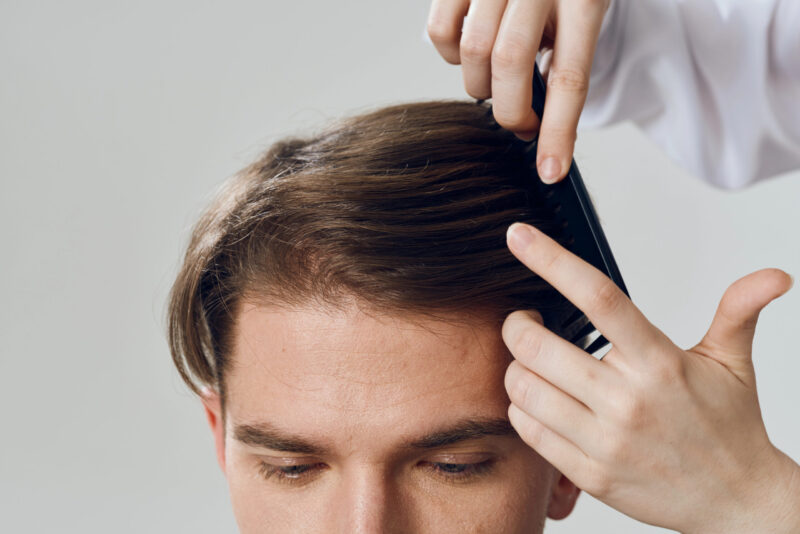In recent years, advancements in the field of hair restoration have led to innovative treatments aimed at combating hair loss, including exosome treatment that can revitalize dormant hair follicles. One such groundbreaking approach is exosomes hair loss therapy, which harnesses the potential of exosomes to stimulate hair growth and improve hair density. This article delves into the causes of thinning hair and hair loss and explores how exosome therapy can be a revolutionary solution for individuals struggling with a thinning head of hair.
Understanding Hair Loss and its Causes
Hair loss is a multifaceted condition that can affect individuals of all ages and backgrounds. Understanding the various types of hair loss and their underlying causes is crucial in determining the most effective treatment strategies. Hair loss or thinning can occur due to genetic factors, hormonal changes, medical conditions, or environmental influences. By gaining insight into these factors, individuals can better address their specific hair restoration needs.
Types of Hair Loss
There are several types of hair loss, each with distinct characteristics. Androgenetic alopecia, commonly known as male or female pattern baldness, is the most prevalent form. Other types include telogen effluvium, which involves a temporary shedding of hair due to stress or hormonal changes, and alopecia areata, an autoimmune disorder that leads to patchy hair loss. Recognizing the type of hair loss is essential for tailoring an effective hair treatment plan, including the use of exosomes for hair restoration.
Common Causes of Thinning Hair
Thinning hair can arise from a variety of causes, including hormonal changes and stress, making a comprehensive treatment approach essential for effective hair regeneration. Hormonal imbalances, particularly those related to thyroid issues or menopause, can significantly impact the hair and scalp, leading to challenges in achieving healthier hair. Additionally, nutritional deficiencies, such as a lack of vitamins and minerals, can hinder hair follicle development and lead to hair loss, making it vital to consider these factors in your usual hair care routine. Stressful life events may also trigger hair thinning, emphasizing the need for a comprehensive approach to hair loss treatment that addresses both physical and emotional factors, including the potential benefits of exosome treatment.
The Impact of Hair Loss on Individuals
The impact of thinning hair and hair loss extends beyond physical appearance, often affecting an individual’s self-esteem and confidence. As hair thinning becomes more pronounced, many individuals may feel self-conscious, leading to social withdrawal and emotional distress, which can further complicate their journey towards hair regeneration. Effective hair restoration treatments, such as exosome therapy, hold promise not only for stimulating hair growth but also for improving the quality of existing hair, thus enhancing overall well-being and confidence in those affected by hair loss.
Exploring Exosome Therapy
What are Exosomes?
Exosomes are tiny particles released by stem cells within the human body and are around 30-150nm in diameter. They act as vital messengers, circulating in the bloodstream and carrying essential proteins, growth factors, and even DNA. By facilitating communication between cells, exosomes play a crucial role in regulating hair follicle regeneration, making them particularly effective in hair growth treatments. Their regenerative properties are invaluable in addressing hair loss.
How Exosomes Work in Hair Restoration
Exosomes are small messenger particles produced by specific types of cells, allowing for effective cellular communication and response. When a doctor injects exosomes into the scalp, these particles signal the hair follicles to initiate hair growth. By stimulating dormant hair follicles, exosomes can enhance the hair growth cycle, resulting in the emergence of new hair. This targeted approach is a promising advancement in hair restoration therapies, particularly in its ability to contain growth factors that support hair thickness and regeneration.
Benefits of Exosome Therapy for Thinning Hair
Exosome therapy presents numerous advantages as a treatment for hair loss. This minimally invasive procedure is associated with reduced downtime and recovery, making it an attractive option for individuals seeking hair restoration. By stimulating natural hair growth and reducing inflammation, exosomes enhance cellular regeneration and promote blood flow to the scalp, ultimately improving hair quality. Patients can expect long-lasting results suitable for various hair types, particularly when incorporating exosome treatment into their regimen.
Exosomes for Hair Growth
Scientific Evidence Supporting Exosome Use
Research indicates that exosomes significantly contribute to stimulating the formation of new blood vessels, a process known as angiogenesis, which is crucial for promoting hair growth. This mechanism ensures that hair follicles receive an abundant supply of essential nutrients and oxygen, which is vital for hair follicle development. Improvements in hair density and thickness can often be observed within a few weeks, with new hair growth becoming increasingly noticeable after several months of exosome therapy combined with other hair treatments.
Exosomes vs. Traditional Hair Loss Treatments
Exosome hair therapy represents a new approach to hair restoration compared to traditional hair loss treatments. While research is ongoing, the initial results of exosome therapy have shown promise, often yielding less invasive solutions than conventional hair transplants, and may contain growth factors that enhance hair restoration. This innovative method can provide long-lasting results, making it a compelling option for those seeking effective treatments for hair loss and thinning hair.
Case Studies: Success Stories of Exosome Therapy
Numerous case studies have emerged showcasing the success of exosome therapy in promoting hair regrowth. Patients who have undergone this treatment report significant improvements in hair density and thickness, often revitalizing their confidence and self-esteem, especially when combined with other hair treatments. By harnessing the regenerative power of exosomes, these individuals have experienced a successful transformation, demonstrating the potential of exosome therapy as a leading hair loss treatment.
Exosome Therapy for Hair Loss: The Procedure
Initial Consultation and Assessment
Before embarking on any exosome therapy for hair restoration, it is essential to attend an initial consultation and assessment to understand how it can help stimulate the hair and revitalize dormant hair follicles. This meeting allows healthcare professionals to evaluate your specific situation concerning hair loss or thinning. During the consultation, potential candidates can discuss their expectations and explore the most effective treatment plan tailored to their unique symptoms and hair growth needs.
The Exosome Injection Process
The exosome hair restoration process begins with the extraction of exosomes derived from stem cells. A blood draw is performed to gather the necessary material, and advanced techniques are employed to isolate and purify the exosomes. Once prepared, these potent exosomes are injected directly into the scalp at the sites of hair loss or thinning, stimulating dormant hair follicles and promoting new hair growth.
Post-Treatment Care and Expectations
After undergoing exosome therapy for hair loss, patients typically can resume their daily activities immediately. However, proper post-treatment care is crucial for optimal results. It is advisable to avoid washing your hair for at least 24 hours and to refrain from using harsh hair care products for a few days after the treatment, ensuring the best possible outcome in hair density and thickness.
Combining Exosome Therapy with Other Treatments
Exosome Therapy and PRP
Combining exosome therapy with Platelet-Rich Plasma (PRP) enhances the effectiveness of hair restoration efforts, encouraging the growth of new hair. PRP, rich in growth factors, can further stimulate hair follicles, making the fusion of these two treatments a powerful approach to combatting hair loss. This synergistic effect can lead to improved hair density and promote healthier, thicker hair, providing a comprehensive solution for individuals struggling with thinning hair, especially when combined with other hair treatments.
Complementary Hair Treatments for Enhanced Results
In addition to exosome therapy and PRP, various personalized treatment options can enhance overall results. Procedures such as laser therapy or topical minoxidil, when combined with exosomes for hair loss, can further stimulate hair follicle development and accelerate the hair growth cycle. This multifaceted approach allows patients to achieve optimal hair restoration outcomes, maximizing the potential for new hair growth and improved hair quality.
Long-Term Maintenance and Follow-Up Care
Long-term maintenance is vital to sustaining the benefits of exosome therapy for hair loss. Regular follow-up care enables healthcare providers to monitor progress and make necessary adjustments to treatment plans. Engaging in ongoing assessments can help ensure that hair maintenance aligns with the evolving needs of hair follicles, supporting continued hair regrowth and overall health of the scalp and hair, including hair follicle revitalization.
Frequently Asked Questions
How often should I do exosomes for hair?
The frequency of exosome therapy for hair restoration can vary based on individual needs and the severity of hair loss. Generally, practitioners recommend an initial series of exosome hair loss treatments spaced a few weeks apart, followed by maintenance sessions every few months. This schedule allows for optimal stimulation of hair follicles and ensures sustained hair growth over time.
How Exosomes treat thinning hair and prevent hair loss?
Exosomes play a crucial role in treating thinning hair and preventing hair loss by delivering growth factors and regenerative signals directly to hair follicle stem cells. These tiny particles stimulate dormant hair follicles, promoting the hair growth cycle and enhancing hair density. By nourishing the scalp and improving blood circulation, exosomes may significantly impact hair restoration efforts, stimulating the hair and encouraging the growth of healthier hair.
Not sure if exosome hair therapy is right for you?
If you are uncertain whether exosome hair therapy is the appropriate treatment for your hair loss concerns, it is essential to consult with a qualified healthcare provider. They can assess your specific hair loss or thinning situation and provide personalized recommendations based on your hair growth needs, ensuring you receive the most effective treatment options available.
Are there any side effects of the Exosomes hair loss treatment?
Possible side effects of autologous exosomes hair treatment include pain, redness, and swelling at the injection site. While these reactions are typically mild and resolve quickly, some patients may experience discomfort or tenderness following the procedure. Understanding these potential side effects can help set realistic expectations for those considering exosome hair loss treatment for hair loss.
Both PRP and exosomes have shown impressive results in hair restoration, but which one is right for you?
Choosing between PRP and exosome therapy for hair restoration depends on various factors, including your specific hair loss condition and treatment goals. While PRP uses concentrated platelets to stimulate hair growth, exosomes for thinning hair leverage the regenerative properties of stem cell-derived particles. A thorough consultation with a specialist can help determine which personalized treatment option will best meet your needs.
You now understand how exosome hair treatments work, but what can you expect?
Patients can typically expect to see the best results in hair density and thickness within a few weeks of exosome therapy, with new hair growth becoming more noticeable after several months. The therapy can potentially halt or slow the progression of hair loss, providing enduring benefits for patients and enhancing their overall hair health and appearance.
Conclusion: The Future of Hair Restoration
Potential Advancements in Exosome Therapy
As research continues to evolve, the potential advancements in exosomes hair loss therapy for hair restoration are promising. Future studies may uncover new methods to enhance the efficacy of exosomes for hair loss work, possibly integrating them with light therapy to optimize results. This ongoing innovation could revolutionize the landscape of hair restoration, offering more effective solutions for patients.
Final Thoughts on Hair Restoration Options
In summary, exosome therapy represents a cutting-edge approach to hair restoration that shows significant potential for those experiencing hair loss or thinning, particularly in encouraging the growth of healthier hair. As patients explore their treatment options, understanding the benefits and mechanisms of exosome therapy can empower them to make informed decisions about their hair health and restoration journey.
Encouragement to Seek Professional Consultation
Individuals seeking effective solutions for hair loss should pursue a professional consultation to discuss exosome therapy and other available treatments. A qualified expert can provide personalized insights, recommend tailored treatment plans, and help patients navigate their options for achieving healthy hair growth and restoring confidence in their appearance.
*Information in this article is not medical advice and may not be factually accurate. It is intended for entertainment purposes only. Consult with a physician before attempting any tips in this blog post and to get the most up to date factual data about any procedure or treatment.














